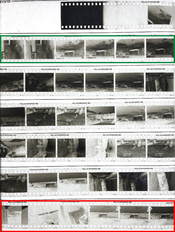A film which I do not use. I only use major film manufacturers, but my statement still stands that manufactures know more about the film any of us ever will.
So you don't use the film in question ? Ever ?
Try it , experiment . Then you'll have some experience with this film that you can share .
The trouble is , especially with a specialist type film , when you deviate from the manufacturers intended use , to get the results in a way that you prefer , the manufacture doesn't tell you how to do that .
Their data sheets guide you how to get the best of it in what they consider it's intended use only . YMMV .
Metering through a darker filter of any color will not be accurate because the meter's spectrum does not cover the complete visual spectrum evenly. The filter's and the meter's spectrums are different and readings are inaccurate. Always use the manufacturer'e filter factore.
Again , here's where experience comes in of a particular film , meter , camera and filters combination comes in .
That's a very general statement that's often true , but not always 100% accurate in real world use .
An example of which is my use of Rollei IR film .
I mostly use it in 120 and 5"x4" where I use a Minolta Spot meter and the filter factor of the filter in use ( I use several ) .
However , if I'm using the Rollei IR in 135 , I typically use it in my Minolta Dynax 9 ( Maxxum 9 in the states ) , typically with a Minolta 24mm f/2.8 lens attached , and with a B&W 092 or Hoya r72 filter attached and the ISO set to 320 , it gives consistent reading to my Minolta Spot meter with the filter factor adjusted taken into account by setting the ISO the equivalent extra stops needed .
Other camera/lens/filter combinations might not give consistent readings .
Still the research and development has been done while the film was being designed and quality control still have more knowledge than any amateur knows.
Except they don't know how that amateur is planning on using , exposing and developing their product , and what with .
Sometimes you've got to work it out for yourself .
Shooting a few test rolls first answers most of your questions before you start using it proper .
I am not talking about people like you who have carefully worked out their personal EI, I am referring to people to read something on the internet or pick up in a discussion who derate the ISO and have not thought it through themselves.
Sometimes hard to tell which is which though .
Can’t for the life of me think why manufacturers rate a film at 400, when most people seem to think it should be 200 or less…really frustrating for inexperienced users.
I'm not sure if you've misunderstood what you've read .
I've never seen Rollei IR being recommended being exposed as an ISO 200 film , with or without an IR filter .
That doesn't make sense .
Without a filter for standard B&W photography it exposes correctly at ISO 400 . I've done mixed IR and non IR shots on the same roll , and exposure is consistent with the figures I use .
If using a 720nm IR pass filter you can use the filter factor to correct expose when metered at ISO 400 .
If you want to avoid doing maths each time you take a meter reading you can just set the meter to a lower ISO to give you the final figure .
This is when you are not metering threw the filter .
With infrared film , your mid grey target that you meter off for regular B&W film , don't always work for IR .
A lump of old weathered gritstone will be fine for either , so meter set to ISO 25 if spot metering off it ( i.e. a reflective spot meter reading ) or using a hand held light meter ( non reflective ) .
But for landscape shooters ( in Europe anyway , not an American desert ) green grass is like metering off snow with IR , so meter typically set for extra exposure ( like a snow scene in regular B&W) if your metering reflected light , i.e with your cameras centre weighted meter and without a filter attached , or if your using a spot meter and you've only light green foliage to meter off ISO 6 takes care of that . Some people prefer to take a reading as ISO 12 . YMMV .
As said , with an IR filter attached to the lens on my Dynax 9 with is ISO set to 320 , the meter readings are consistent with the above , that's where the 320 comes from .
Other cameras might not work like that or give inconsistent readings .
I've used manual focus cameras for Rollei IR film too , but can only see the meter readings without a filter attached .
@"super_claret" , I hope that makes it clearer for you where these numbers other than ISO 400 come from .
Again , shoot a few rolls of the film and form your own opinion rather than just what a data sheet tells you .
The roll of film you've already exposed will wait for development until you try a few test pieces of a test roll developed in the 510-Pyro , but you might just want to get a different developer for this that you can use in your rotary processor .
Or for the sake of one roll , try the semi stand method on MDC .









